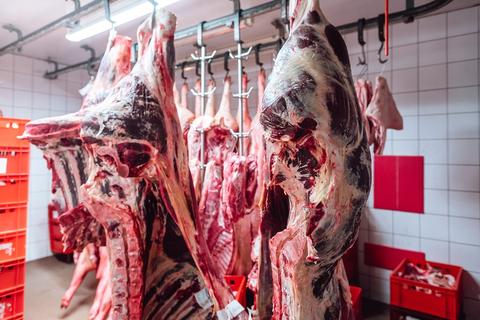Posted by Brian Shilhavy on Apr 28, 2020

One rancher in Texas speaks out. Texas state officials are reportedly advising Texas ranchers how to depopulate and dispose of their beef, while at the same time beef is still being imported into the U.S. from other countries.
Meat processor shutdowns = prime time for PRIME Act
by Farm and Ranch Freedom Alliance
In the last week, the media headlines have included concerns about possible meat shortages. Livestock farmers and ranchers across the country are verging on bankruptcy – while consumers are facing increasing prices and empty shelves in the groceries.
With hundreds of millions of livestock and poultry in this country, why are we having these problems?
COVID-19 is not the reason for the problems, it’s just the straw that is breaking the camel’s back in our deeply flawed food system. Four companies control processing of over 80% of the country’s beef, and four companies control processing of two-thirds of the country’s pork. The consolidation has led to most meat being processed at massive plants where as many as 400 cattle are slaughtered an hour. Workers in these facilities labor under very difficult and often unsafe conditions – and that’s before you add in the issue of a highly contagious disease.
Yet the government regulations are designed for these massive, industrial-scale facilities, making it difficult or sometimes even impossible for small-scale facilities to comply. And federal law requires that “state inspected” facilities use the exact same USDA standards, leaving no flexibility for states to develop standards better suited to small operators.
So we have a shortage of small-scale processors in this country, and small-scale livestock farmers have few places they can take their animals for processing. In some areas of the country, the nearest USDA or equivalent state facility may be several hours’ drive away or more.
There are alternatives, known as “custom slaughterhouses,” which legally operate in many states. But the meat from them can only be provided back to – and consumed by the family of – the person who owned the animal when it entered the slaughterhouse. A consumer who is not able to pay for and store hundreds of pounds of meat in one order is unable to access the meat from a custom slaughterhouse. And a farmer who wants to sell his or her beef, lamb, goat, or pork to consumers at a local farmers’ market or other local outlet cannot use a custom slaughterhouse.
The PRIME Act, H.R. 2859/ S.1620, addresses this problem and can help with both the short-term crisis and the long-term change we need in our food system. TAKE ACTION TO SUPPORT THIS IMPORTANT BILL.
The PRIME Act repeals the federal ban on the sale of meat from custom slaughterhouses. The bill returns control to the states to address the issue of meat processing. States would be able to permit producers to sell meat processed at a custom slaughterhouse within the state. States could choose to impose whatever conditions or limitations that best suited their particular agricultural, food system, and social conditions.
These facilities meet state regulations as well as basic federal requirements. They are typically very small with few employees. The extensive and complicated federal regulations that apply to massive meatpacking facilities are neither needed nor appropriate for these operations, which might process as much meat in an entire year as the large facilities do in a single day. Their small scale also means that they are better able to provide necessary social distancing and sanitation measures while safely continuing operations.
The PRIME Act could help improve access and reduce meat prices for consumers in the coming months, while providing income for small farmers and ranchers across the country. And it has many long-term benefits:
- Help establish vital infrastructure in rural communities.
- Improve farmers’ incomes and opportunities.
- Increase consumers’ access to locally raised meats.
- Reduce stress on animals from long-distance hauling.
- Reduce transportation miles and greenhouse gases.
The PRIME Act has bipartisan support, but it has languished with no committee hearing or movement. Will you help?
TAKE ACTION #1: Do you represent a non-profit organization, or own a farm or ranch?
Sign on to our letter to the House Agriculture Committee urging them to move the PRIME Act forward!
Just fill out this form: https://forms.gle/qSMx8kZohyc9aAQH6
If you have problems with the form, email Info@FarmAndRanchFreedom.org with your name, the name of your organization/farm, the type of entity (national nonprofit, regional or state nonprofit, local nonprofit, or farm/ranch), your title with the entity, and the state you are located in.
TAKE ACTION #2: For everyone
Call your U.S. Representative and Senators and urge them to sign on to H.R. 2859 and S. 1620. You can look up who represents you here or call the Capitol Switchboard at 202-224-3121.
Below is a sample message for your call or email. Remember that calls have a greater impact, and only take a couple of minutes. Use this sample message as a starting point – tailor it to your own language and focus on why this issue is important to you. Personalized messages are the best way to convince legislators!
As a constituent, I urge Representative ____ to co-sponsor H.R. 2859, the PRIME Act. [OR: I urge Senator ___ to co-sponsor S.1620, the PRIME Act.]
As Americans face potential meat shortages due to the closing of massive meatpackers, it is more important than ever to revitalize our local food production and processing. The PRIME Act opens up options for small livestock farms and ranches by removing the federal ban on the sale of meat from custom slaughterhouses within a state, subject to state law. This returns power to the states to establish a regulatory scheme that makes sense for their citizens.
At a time when we see empty grocery store shelves, and media headlines about the failure of massive meatpacking companies to safely secure our food supply, this bill provides vital opportunities – and many long-term benefits. The PRIME Act supports local food production and small businesses, while also reducing vehicle miles traveled with livestock trailers, and helping to meet the consumer demand for locally raised meat.
Please support consumers and small farmers by co-sponsoring H.R. 2859.
Name
City, State
If you are a livestock producer, take a few extra minutes and ask to speak to the staffer who handles agricultural issues. Briefly explain to the staffer any problems you have faced with lack of access to inspected slaughterhouses, and how the PRIME Act would help your business and benefit your customers.
NOTE: If your Representative is already a co-sponsor, be sure to say, “Thank you!” when you call.
H.R. 2859 co-sponsors:
Justin Amash (R-MI)
Andy Biggs (R-AZ)
Tim Burchett (R-TN)
Joe Courtney (D-CT)
Rodney Davis (R-IL)
Jeff Duncan (R-SC)
Matt Gaetz (R-FL)
John Garamendi (D-CA)
Jared Golden (D-ME)
Mark Green (R-TN)
Jared Huffman (D-CA)
Steve King (R-IA)
Thomas Massie (R-KY)
Tom McClintock (R-CA)
Mark Meadows (R-NC)
Carol Miller (R-WV)
Alexander Mooney (R-WV)
Scott Perry (R-PA)
Chellie Pingree (D-ME)
Elise Stefanik (R-NY)
Rashida Tlaib (D-MI)
Robert Wittman (R-VA)
S. 1620 was filed by Senator Angus King (I-ME) and is co-sponsored by Rand Paul (R-KY), Lamar Alexander (R-TN), and Marsha Blackburn

